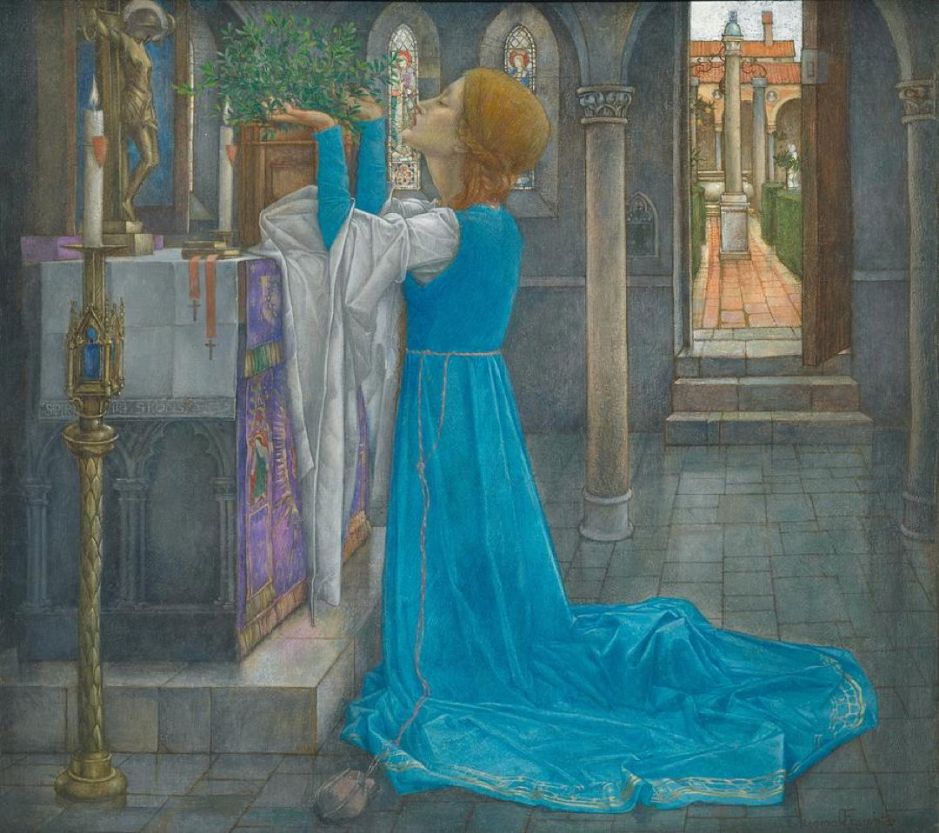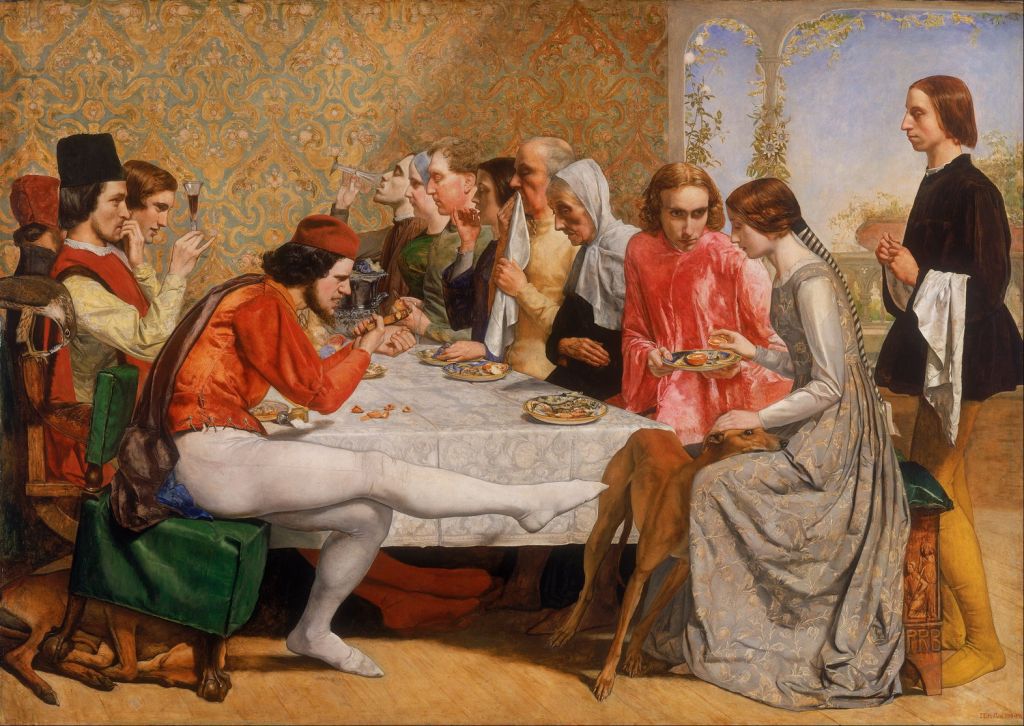With the barriers to development of British narrative painting removed, it wasn’t long before its first school arose. As in so many cases, it appears to have developed entirely unintentionally, among a group of young men studying at the Royal Academy Schools in London, in 1848: the Pre-Raphaelites. Although they didn’t mention history or narrative painting in the manifesto of the short-lived core Pre-Raphaelite Brotherhood, from their earliest works it was their central genre.

John Everett Millais’ Christ in the House of His Parents (also known as The Carpenter’s Shop) (1849–50) was shown at the Royal Academy in 1850 without a title, but with this quotation from the Old Testament book of Zechariah 13:6: “And one shall say unto him, What are those wounds in thine hands? Then he shall answer, Those with which I was wounded in the house of my friends.” It shows an entirely imagined scene, one not even alluded to in the Gospels, in which the young Jesus Christ is being comforted by his kneeling mother, after he has cut the palm of his left hand on a nail.
The figures and objects are depicted with great and meticulous realism, and were painted from nature. Nevertheless the composition abounds with symbols of Christ’s life and future crucifixion: the cut on his palm is one of the stigmata, and blood dripped from that onto his left foot is another. The young Saint John the Baptist has fetched a bowl of water, indicating his future baptismal role. A triangle above Christ’s head symbolises the Trinity, and a white dove perched on the ladder is the Holy Spirit. A flock of sheep outside represents the Christian flock.

Dante Gabriel Rossetti’s painting of The Girlhood of Mary Virgin (1848–9) not only depicts an imaginary scene, but one containing overt anachronisms. The young Mary is embroidering with her mother, Saint Anne, while her father, Saint Joachim, prunes a vine, by Rossetti’s time, a socially acceptable activity for a gentleman. Rossetti uses Mary’s embroidery to introduce the symbolic colour red, signifying the Passion to come, and this slow, painstaking activity as a symbol of the demands of motherhood.

Rossetti departs from convention throughout his painting of the Annunciation, using a title from the Vulgate text of Ecce Ancilla Domini! (1849–50). It combines great naturalism in its figures with deeply traditional plate-like gilt halos, and features a rich language of symbols including white robes for purity, red embroidery for Christ’s crucifixion, a blue curtain for heaven, and flames at the feet of Gabriel rather than angel’s wings.
Although early Pre-Raphaelite narratives were consistent in many respects, both those who had been members of the original, fleeting Brotherhood and those who joined the broader movement were more diverse. This is best illustrated by paintings of one story drawn from Boccaccio’s Decameron, the tragic tale of Lisabetta related by Filomena on the fourth day, when it was the fifth about those whose love ended unhappily.
In 1818, the British poet John Keats (1795-1821) wrote his version, titled Isabella, or the Pot of Basil, which was published two years later, shortly after the poet’s untimely death at the age of just twenty-five. It became one of his most popular works in the nineteenth century. Here I will summarise Boccaccio’s original, using his version of the names, mindful that Keats called his leading lady Isabella rather than Boccaccio’s Lisabetta. Her lover’s name, common to both authors, is Lorenzo.
Following the death of a rich merchant of Messina, his three sons inherited his riches. Their sister remained unmarried despite her beauty and grace. Lisabetta and Lorenzo, a Pisan who directed operations in one of the brothers’ trading establishments, fell in love with one another, and their relationship was consummated. The couple had tried to keep their affair secret, but one night she was observed by one of her brothers making her way to Lorenzo’s bedroom; Lisabetta remained unaware of this discovery. Her brother was distressed by this, but decided to keep quiet, and discuss it with his brothers next morning.
The following day, the brothers decided that they would also keep quiet until the opportunity arose to end their sister’s relationship. One day they pretended that they were going to the country for pleasure, and took Lorenzo with them. When they reached an isolated location, the three murdered Lorenzo and buried his body. They then told their sister that they had sent him away on a trading mission.
Lisabetta was anxious for her lover’s return, and persistently asked her brothers for news of him. Eventually, one of them rebuked her for this nagging, so she stopped mentioning him altogether. But each night she kept repeating his name and pining for him. One night, having finally fallen asleep in her tears, she saw him in a dream, in which he said that her brothers had murdered him, and revealed where his body was buried.
In her grief, Lisabetta obtained the permission of her brothers to go to the country for pleasure. Once she had located where she thought Lorenzo was buried, she quickly found his corpse, which remarkably showed no signs of decay. As she couldn’t move his whole body for more appropriate burial, she cut off his head and concealed it in a towel.
When she returned home, Lisabetta cried greatly over Lorenzo’s head, washing it with her tears, then wrapped it in cloth and put it in a large pot. She covered it with soil and in that planted some sprigs of basil. These she watered daily with her tears, as she sat constantly beside the pot in between bouts of crying over it. As a result, the basil grew strong and lush, and richly fragrant.
Her brothers began to suspect something, so had the pot removed from her room. This caused their sister deeper grief, and she kept asking after the pot. The brothers examined its contents and discovered Lorenzo’s head. Scared that his murder might cause problems for them, they reburied the head, wound up their business, and left Messina for Naples. Lisabetta’s grief only grew deeper, and destroyed her health completely. Still asking for her pot of basil, she finally cried herself to death.

The first and still greatest depiction of Keats’ retelling is John Everett Millais’ Isabella (Lorenzo and Isabella) from 1848-49, completed before he was twenty, and from the same early period of Pre-Raphaelite paintings as the examples above. This is a composite of different references to Keats’ poem and Boccaccio’s story, set at an imaginary family meal which the three brothers, Lisabetta and Lorenzo are taking together.
Lorenzo is sharing a blood orange with Lisabetta, white roses and passion flowers climbing from behind their heads. The dog, acting as a surrogate for Lorenzo, is being petted by Lisabetta, but one of her brothers aims a kick at it. Various other symbols are shown of the plot to kill Lorenzo: a brother staring at a glass of red wine, spilt salt on the table, and a hawk pecking at a white feather. The pot of basil is already on the balcony, awaiting Lorenzo’s head.
When exhibited at the Royal Academy in 1849, it was accompanied by verses 1 and 21 of Keats’ poem.

William Holman Hunt’s Isabella and the Pot of Basil from 1867 is intricately detailed, with several references to elements of the story, such as the relief of a skull on the side of the pot, a red rose on a tray by Lisabetta’s left foot, and a silver watering can at the bottom right. Behind her is the image of a bedroom, possibly showing Lorenzo coming to her in a flashback to their affair.

John Melhuish Strudwick’s Isabella from about 1886 shows Lisabetta staring in grief at the stand on which her pot of basil had stood. Through the window, two of her brothers are seen making off with the pot, and looking back at her.

Ricciardo Meacci’s watercolour of Isabella and the Pot of Basil from 1890 shows Lisabetta embracing her pot of basil, as her three brothers watch with growing anger at her behaviour.

Edward Reginald Frampton’s Isabella, or the Pot of Basil was probably painted towards the end of the nineteenth century, or possibly in the early twentieth, at the end of the Pre-Raphaelite movement. Lisabetta is kneeling before her pot of basil at an altar, with a crucifix behind.
As narrative paintings, these demonstrate an approach built from relatively small details, clues to the story, carefully assembled into more static scenes which don’t attempt to portray moments of climax or peripeteia. At last they are characteristic of if not unique to the British painting of this period, and precursors of novel visual narrative such as ‘problem pictures’.

